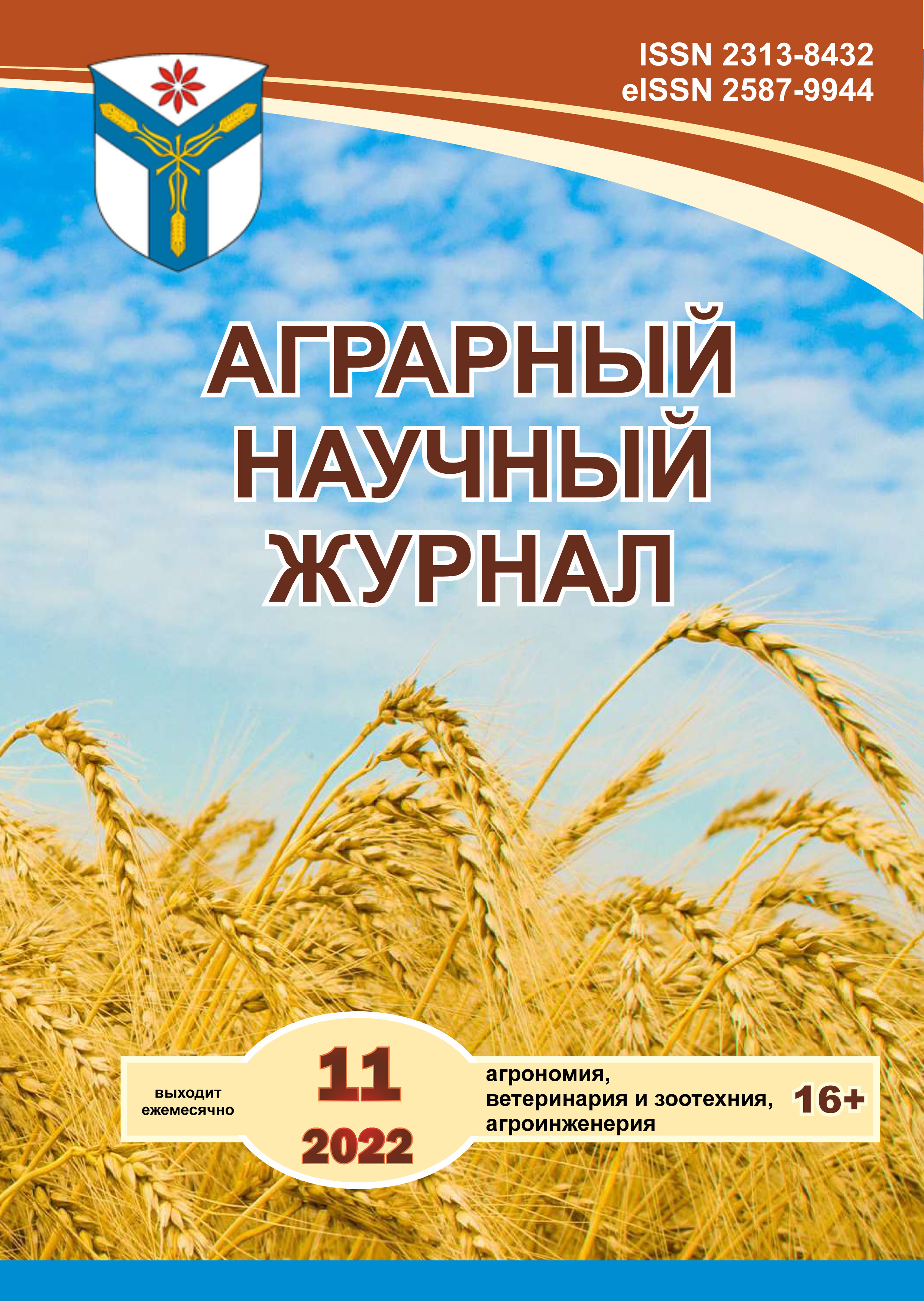Correlation between the concentration of chemical elements in wool and the quantitative and qualitative characteristics of the semen in Holstein bulls
DOI:
https://doi.org/10.28983/asj.y2022i11pp91-95Keywords:
sire bull, semen quality, reproductive qualities, elemental status, calcium, aluminumAbstract
The effect of concentrations of 25 chemical elements in wool on the quantitative and qualitative characteristics of sperm was studied in Holstein sires (n = 55), age 3-4 years, in the conditions of JSC "Nevskoye" by breeding work in Leningrad region. Wool samples were collected from the top of the withers and determined by the AES-ISP method. The interrelation of quantitative and qualitative characteristics of the sperm was revealed with two chemical elements: calcium and aluminum. Thus, as the calcium concentration in wool increases from 604±194.8 mg/kg to 3690±460.3 mg/kg, the volume of native sperm increases by 55.8% (P?0.01), spermatozoa activity increases by 0.14 points (Р?0.05), diluted semen yield – by 95.1% (Р?0.01), number of frozen doses – by 82.6% (Р?0.05). An increase in aluminum concentration from 1.89 mg/kg to 8.46 mg/kg is accompanied by a decrease in the concentration of spermatozoa by 20.4% (P?0.001), activity - by 0.21 points (P?0.05), number of frozen doses - by 55.4% (P?0.01).
Downloads
References
Необходимость учета региональных особенностей в моделировании процессов межэлементных взаимодействий в организме человека / С.В. Нотова [и др.] // Вестник Оренбургского государственного университета. 2006. № 52. С. 59–63.
The relationship between semen quality and mineral composition of semen in various ram breeds / H. A. Abdel-Rahman et al. // Small Rumin Res. 2000 Sep 1;38(1):45–49. DOI: 10.1016/s0921-4488(00)00137-1.
Andrieu S. Is there a role for organic trace element supplements in transition cow health? // Vet J. 2008 Apr;176(1):77–83. DOI: 10.1016/j.tvjl.2007.12.022.
Barth A. D., Brito L. F., Kastelic J. P. The effect of nutrition on sexual development of bulls // Theriogenology. 2008 Aug;70(3):485–94. DOI: 10.1016/j.theriogenology.2008.05.031.
Xiong X., Lan D., Li J, Lin Y, Li M. Selenium supplementation during in vitro maturation enhances meiosis and developmental capacity of yak oocytes // Anim Sci J. 2018 Feb;89(2):298–306. DOI: 10.1111/asj.12894.
Study of some serum trace minerals in cyclic and non-cyclic surti buffaloes / M. Hedaoo et al. // Vet. World. 2008;(1):71.
Impact of Cu and Fe concentrations on oxidative damage in male infertility / B. Aydemir et al. // Biol Trace Elem Res. 2006;112(3):193–203. DOI: 10.1385/BTER:112:3:193.
Seminal plasma zinc concentration and alpha-glucosidase activity with respect to semen quality / M. Mankad et al. // Biol Trace Elem Res. 2006;110(2):97–106. doi: 10.1385/BTER:110:2:97.
Pesch S., Bergmann M., Bostedt H. Determination of some enzymes and macro- and microelements in stallion seminal plasma and their correlations to semen quality // Theriogenology. 2006 Jul 15;66(2):307–313. DOI: 10.1016/j.theriogenology.2005.11.015.
Are serum zinc and copper levels related to semen quality? / L. Yuyan et al. // Fertil Steril. 2008;89(4):1008–1011. DOI: 10.1016/j.fertnstert.2007.04.028.
Colagar A. H., Marzony E. T., Chaichi M. J. Zinc levels in seminal plasma are associated with sperm quality in fertile and infertile men // Nutr Res. 2009;29(2):82–88. DOI: 10.1016/j.nutres.2008.11.007.
Trace elements levels in the serum, urine, and semen of patients with infertility / H. S. Sa?lam et al. // Turk J Med Sci. 2015;45(2):443–448. DOI: 10.3906/sag-1402-140.
An overview on role of some trace elements in human reproductive health, sperm function and fertilization process / M. Mirnamniha et al. // Rev Environ Health. 2019;18;34(4):339–348. DOI: 10.1515/reveh-2019-0008.
An in vitro study on reproductive toxicity of aluminium chloride on rabbit sperm: the protective role of some antioxidants / M. I. Yousef et al. // Toxicology. 2007;8;239(3):213–223. DOI: 10.1016/j.tox.2007.07.011.
Pandey G., Jain G. C. A Review on toxic effects of aluminium exposure on male reproductive system and probable mechanisms of toxicity // Int J Toxicol Appl Pharmacol. 2013;3(3):48–57.
Downloads
Published
Issue
Section
License
Copyright (c) 2022 The Agrarian Scientific Journal

This work is licensed under a Creative Commons Attribution-NonCommercial-NoDerivatives 4.0 International License.








